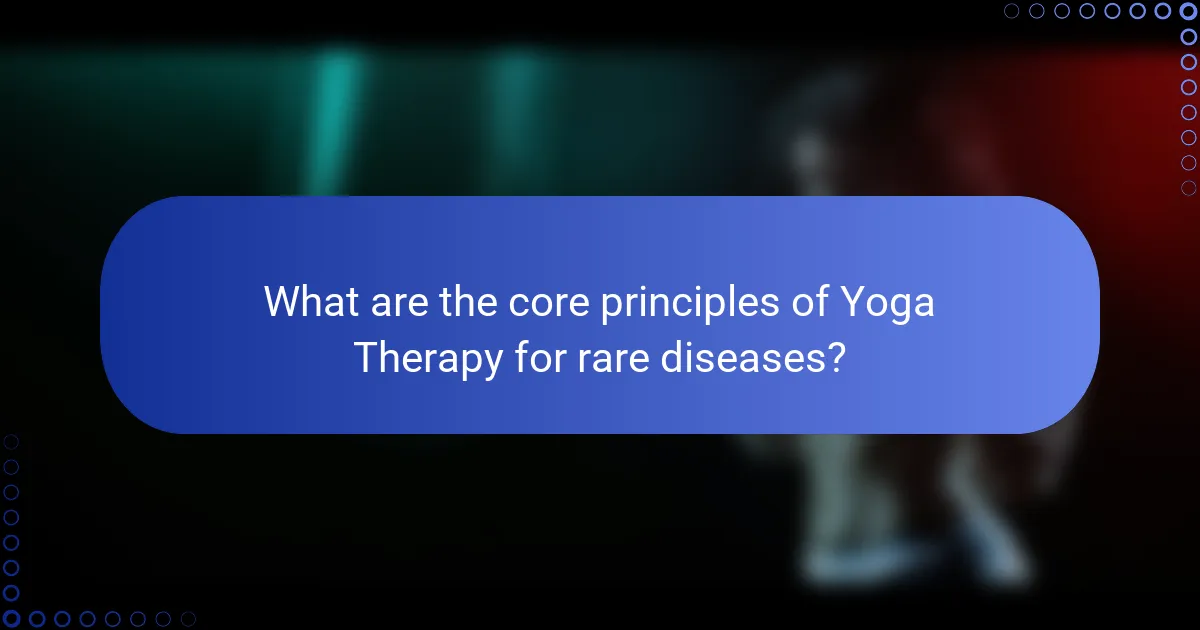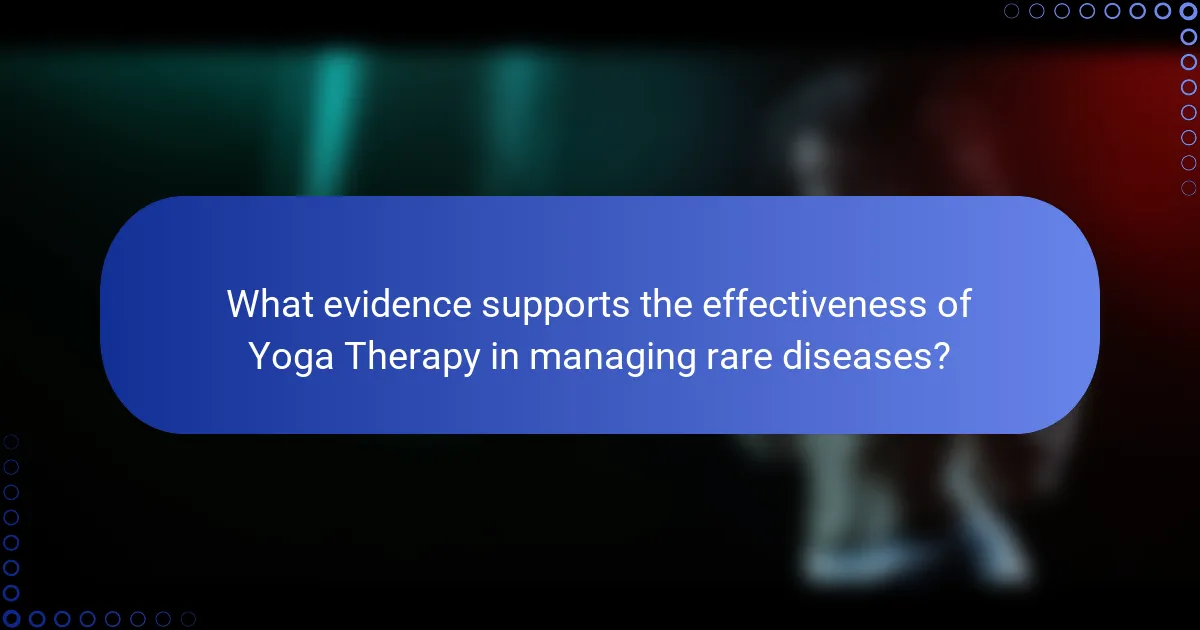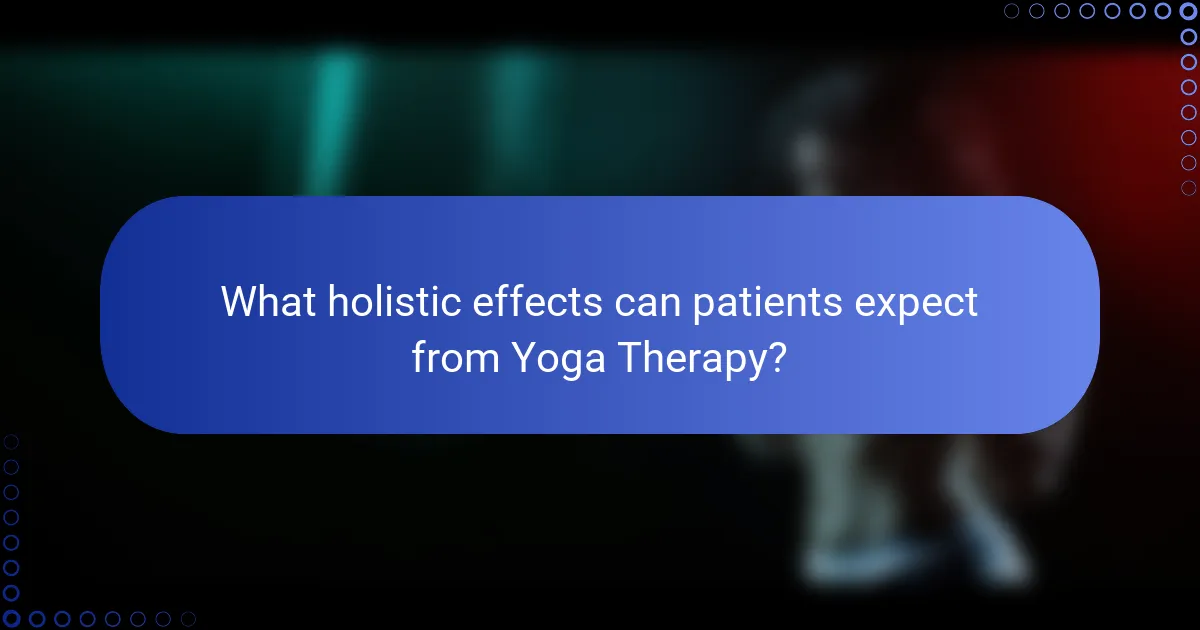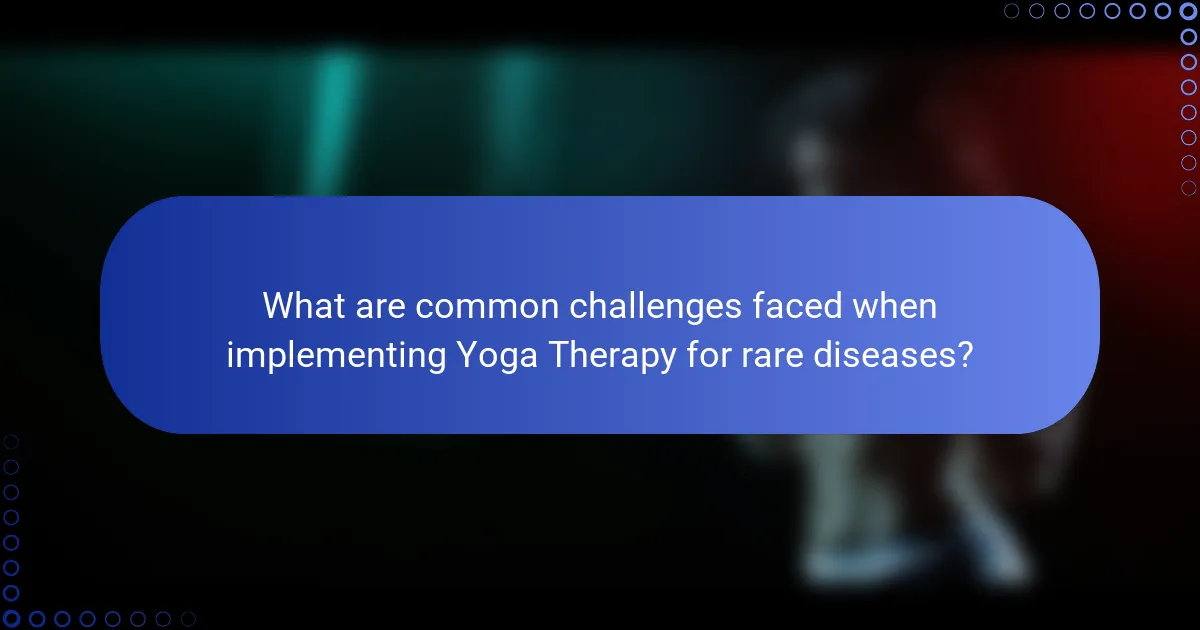Yoga therapy offers a promising approach to enhancing well-being for individuals with rare diseases. This article explores key poses, their benefits, and the holistic effects of yoga therapy. It highlights how tailored practices can improve flexibility, reduce stress, and foster emotional resilience. Additionally, it addresses cultural perceptions and challenges in integrating yoga therapy into treatment plans.

What are the core principles of Yoga Therapy for rare diseases?
Yoga therapy for rare diseases focuses on individualized practices to enhance well-being. Core principles include breath control, mindfulness, and specific poses tailored to the patient’s needs. These practices promote physical, emotional, and mental balance, facilitating healing and improving quality of life.
Key poses often include gentle stretches and restorative postures, enhancing flexibility and reducing pain. Benefits encompass stress reduction, improved mobility, and enhanced mental clarity. Holistic effects can lead to greater self-awareness and emotional resilience, fostering a supportive environment for patients facing unique challenges.
How does Yoga Therapy address physical symptoms of rare diseases?
Yoga therapy effectively alleviates physical symptoms of rare diseases through tailored poses and holistic practices. Specific yoga poses enhance flexibility, reduce pain, and improve circulation, addressing unique challenges faced by individuals with rare conditions. Techniques such as breath control and mindfulness promote relaxation and mental clarity, which are vital for managing symptoms. Additionally, the holistic approach of yoga therapy fosters a sense of community and support, enhancing overall well-being. Regular practice can lead to significant improvements in quality of life for those affected by rare diseases.
What psychological benefits does Yoga Therapy provide for patients?
Yoga therapy provides significant psychological benefits for patients with rare diseases. These benefits include reduced anxiety, improved mood, enhanced emotional regulation, and increased mindfulness. Yoga therapy promotes relaxation and stress relief, which can lead to better mental health outcomes. Studies show that regular practice can enhance self-awareness and foster a sense of community among participants. Additionally, the holistic approach of yoga therapy encourages a deeper connection between mind and body, contributing to overall well-being.

Which specific poses are recommended for individuals with rare diseases?
Gentle yoga poses are recommended for individuals with rare diseases to enhance flexibility and reduce stress. Poses such as Child’s Pose, Cat-Cow, and Seated Forward Bend promote relaxation and improve circulation. These poses can be modified to accommodate individual needs, ensuring safety and comfort. Incorporating breathwork with these poses further enhances their therapeutic effects, fostering a holistic approach to wellness.
How can modified poses accommodate unique physical limitations?
Modified poses can effectively accommodate unique physical limitations by adapting standard yoga techniques. These adaptations allow individuals with rare diseases to engage in yoga therapy safely and beneficially. For instance, using props like blocks or straps can enhance stability and comfort, enabling deeper participation. Additionally, chair yoga provides a supportive environment for those with mobility issues, ensuring they can still reap the holistic benefits of yoga. Each modification focuses on individual needs, promoting accessibility and encouraging a personalized approach to wellness.
What are the best practices for integrating Yoga Therapy into treatment plans?
Integrating Yoga Therapy into treatment plans enhances patient well-being. Best practices include personalized assessments, collaboration with healthcare providers, and consistent practice.
1. Conduct thorough assessments to understand the patient’s unique needs and conditions.
2. Collaborate with medical professionals to ensure a holistic approach.
3. Tailor yoga poses to suit individual capabilities and limitations.
4. Encourage regular practice to reinforce benefits over time.
5. Monitor progress and adjust the plan as necessary to optimize outcomes.

What evidence supports the effectiveness of Yoga Therapy in managing rare diseases?
Yoga therapy shows promise in managing rare diseases through evidence-based practices. Research indicates that specific poses, breathing techniques, and mindfulness can alleviate symptoms and improve quality of life. Studies suggest benefits such as reduced anxiety, enhanced mobility, and pain relief, particularly in conditions like fibromyalgia and rare autoimmune disorders. A unique attribute of yoga therapy is its holistic approach, addressing physical, emotional, and mental health simultaneously. As a result, patients often report increased resilience and better coping mechanisms.
Which studies highlight the benefits of Yoga Therapy for specific conditions?
Studies demonstrate that Yoga Therapy can significantly alleviate symptoms of rare diseases. Research indicates that specific poses improve flexibility and reduce pain, enhancing overall quality of life. For instance, a study on patients with fibromyalgia showed a 30% reduction in pain after a 12-week yoga program. Another study highlighted the benefits of yoga for individuals with rare autoimmune disorders, noting improved fatigue levels and emotional well-being. The holistic effects of yoga extend to mental health, promoting relaxation and reducing anxiety, which is crucial for managing chronic conditions.
How does patient feedback shape the understanding of Yoga Therapy’s impact?
Patient feedback significantly enhances the understanding of Yoga Therapy’s impact on rare diseases. It provides insights into individual experiences, revealing specific benefits and poses that resonate with patients. This qualitative data helps practitioners tailor approaches, ensuring a more personalized and effective therapy experience. Additionally, consistent feedback can highlight unique attributes of Yoga Therapy, such as its holistic effects on mental and emotional well-being, which are often crucial for patients with rare conditions. By integrating patient perspectives, the therapeutic process becomes more responsive and impactful.

What holistic effects can patients expect from Yoga Therapy?
Patients can expect improved physical, mental, and emotional well-being from Yoga Therapy. This practice enhances flexibility, strength, and balance, which are crucial for managing rare diseases. Additionally, it promotes relaxation, reduces stress, and fosters a sense of community among participants. The holistic effects can lead to better pain management and an improved quality of life. Scientific studies highlight Yoga Therapy’s potential to boost immune function and enhance mental clarity, making it a valuable complementary treatment for patients with rare conditions.
How does Yoga Therapy promote overall well-being beyond symptom relief?
Yoga therapy promotes overall well-being by fostering physical, mental, and emotional health. It enhances flexibility, strength, and balance while reducing stress and anxiety. The holistic approach encourages self-awareness, mindfulness, and relaxation, contributing to improved quality of life. Unique benefits include tailored practices for rare diseases, addressing specific needs and symptoms. As a result, yoga therapy not only alleviates symptoms but also supports long-term health and resilience.
What role does mindfulness play in the therapeutic process?
Mindfulness enhances the therapeutic process by fostering awareness and acceptance. In yoga therapy for rare diseases, mindfulness helps patients connect with their bodies, reducing stress and promoting emotional healing. This practice encourages a holistic approach, allowing individuals to navigate their experiences with greater ease. Mindfulness also supports the unique attributes of yoga therapy, such as improved flexibility and pain management, by creating a deeper mind-body connection. As a result, patients can experience significant benefits in their overall well-being.

How does the perception of Yoga Therapy vary across different cultures?
The perception of Yoga Therapy varies significantly across cultures, influenced by historical, spiritual, and health perspectives. In Western cultures, Yoga Therapy is often viewed primarily as a physical practice for improving health and managing rare diseases. This focus emphasizes poses, benefits, and holistic effects, aligning with a medical model.
Conversely, in Eastern cultures, Yoga Therapy is deeply rooted in spiritual traditions and holistic wellness. It encompasses not just physical poses but also mental and spiritual practices aimed at achieving balance and harmony. This broader interpretation includes meditation and breathing exercises, reflecting a unique attribute of cultural significance.
Cultural attitudes towards health also shape perceptions. In cultures that prioritize natural remedies, Yoga Therapy is embraced as a complementary approach to conventional medicine. This contrasts with cultures that favor biomedical interventions, where Yoga Therapy may be regarded with skepticism.
Overall, the perception of Yoga Therapy is a complex interplay of cultural values, beliefs, and health practices, revealing both unique and rare attributes that define its role in different societies.
What cultural beliefs influence the adoption of Yoga Therapy for health?
Cultural beliefs significantly influence the adoption of Yoga Therapy for health, especially in addressing rare diseases. Many cultures view yoga as a holistic practice that promotes balance and well-being. This perspective enhances the acceptance of yoga therapy as a complementary treatment. Additionally, beliefs in the interconnectedness of mind, body, and spirit support its integration into health practices. Cultural narratives surrounding wellness and natural healing further encourage individuals to explore yoga therapy. As a result, these beliefs foster a supportive environment for adopting yoga as a valid therapeutic option.
How do regional practices shape the application of Yoga Therapy?
Regional practices significantly influence the application of Yoga Therapy for rare diseases by integrating local cultural beliefs and therapeutic techniques. These practices adapt the poses and benefits of Yoga Therapy to align with the specific needs of communities. For example, in India, traditional approaches often incorporate Ayurveda, enhancing the holistic effects of Yoga Therapy. In contrast, Western practices may focus on evidence-based techniques, emphasizing measurable benefits. This fusion of regional practices allows for personalized therapy, addressing unique attributes of rare diseases while promoting overall well-being.

What are common challenges faced when implementing Yoga Therapy for rare diseases?
Common challenges in implementing Yoga Therapy for rare diseases include limited research, individualized adaptations, accessibility issues, and patient variability. These factors can hinder effective integration into treatment plans. For example, insufficient evidence may lead to skepticism among healthcare providers. Additionally, adapting poses for specific conditions requires expertise and may not be feasible for all practitioners. Accessibility can be a barrier, as not all patients have access to trained instructors. Lastly, the diverse nature of rare diseases means that responses to yoga can vary significantly among patients, complicating standardization of practices.
How can practitioners overcome barriers to access and engagement?
Practitioners can overcome barriers to access and engagement in yoga therapy for rare diseases by implementing tailored approaches. These strategies include creating inclusive environments, offering virtual sessions, and providing clear communication about the benefits and adaptations of yoga poses.
Additionally, practitioners can collaborate with healthcare providers to integrate yoga therapy into treatment plans, ensuring patients understand its holistic effects. Educating patients about the specific benefits of yoga for their condition can also enhance engagement.
What resources are available for training in Yoga Therapy for rare diseases?
Various resources are available for training in Yoga Therapy for rare diseases. These include specialized online courses, workshops led by certified instructors, and training programs offered by reputable institutions.
1. Online platforms like Yoga Alliance provide comprehensive courses on therapeutic yoga tailored for specific health conditions.
2. Workshops hosted by hospitals or wellness centers focus on integrating yoga therapy into treatment plans for rare diseases.
3. Certification programs from organizations such as the International Association of Yoga Therapists offer in-depth training on the application of yoga for unique health challenges.
4. Community support groups often share resources and personal experiences related to yoga therapy for rare diseases, enhancing learning through practical insights.
These resources equip practitioners with the knowledge and skills necessary to effectively utilize yoga therapy in managing rare diseases.
What expert tips can enhance the effectiveness of Yoga Therapy for patients?
Incorporating expert tips can significantly enhance the effectiveness of Yoga Therapy for patients with rare diseases. Focus on personalized poses tailored to individual needs, emphasizing breath control to promote relaxation.
Regular practice fosters physical and mental resilience, aiding in symptom management. Integrating mindfulness techniques can improve emotional well-being, creating a holistic approach. Collaborating with healthcare providers ensures a comprehensive treatment plan, enhancing overall therapeutic outcomes.